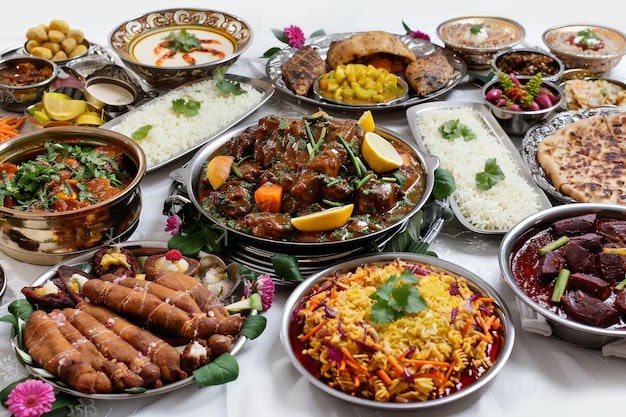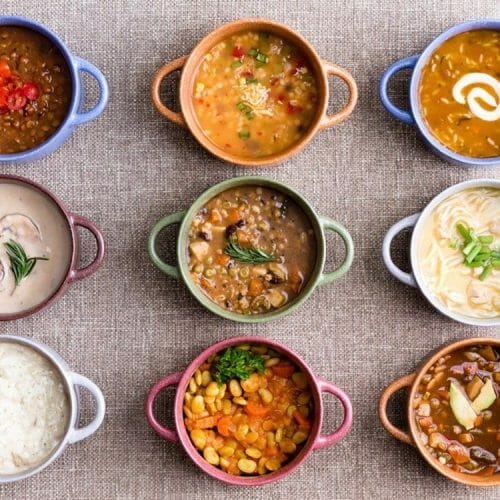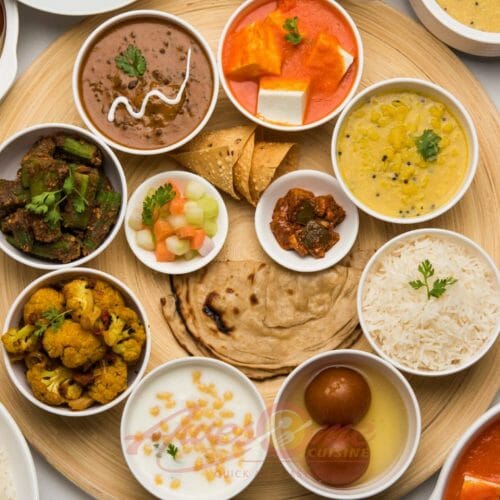Indians cherish biryani. To them, it is a gastronomic savoury delight and a symbol of tradition. Records say that Indians ordered 7.6 crore biryani in the last 12 months. Statistics apart, the charm of biryani lies in its rich flavours and its layered past. This journey will take us from the Mughal courtyards, South Indian coastlines, and various era bakeries, shedding light on colourful biryani history.
By the way, do you know that International Biryani Day is held on 7th July, and it’s promoted by the world-famous Daawat rice brand globally? This blog will take you on a biryani-based journey.
Origins and Etymology of Biryani
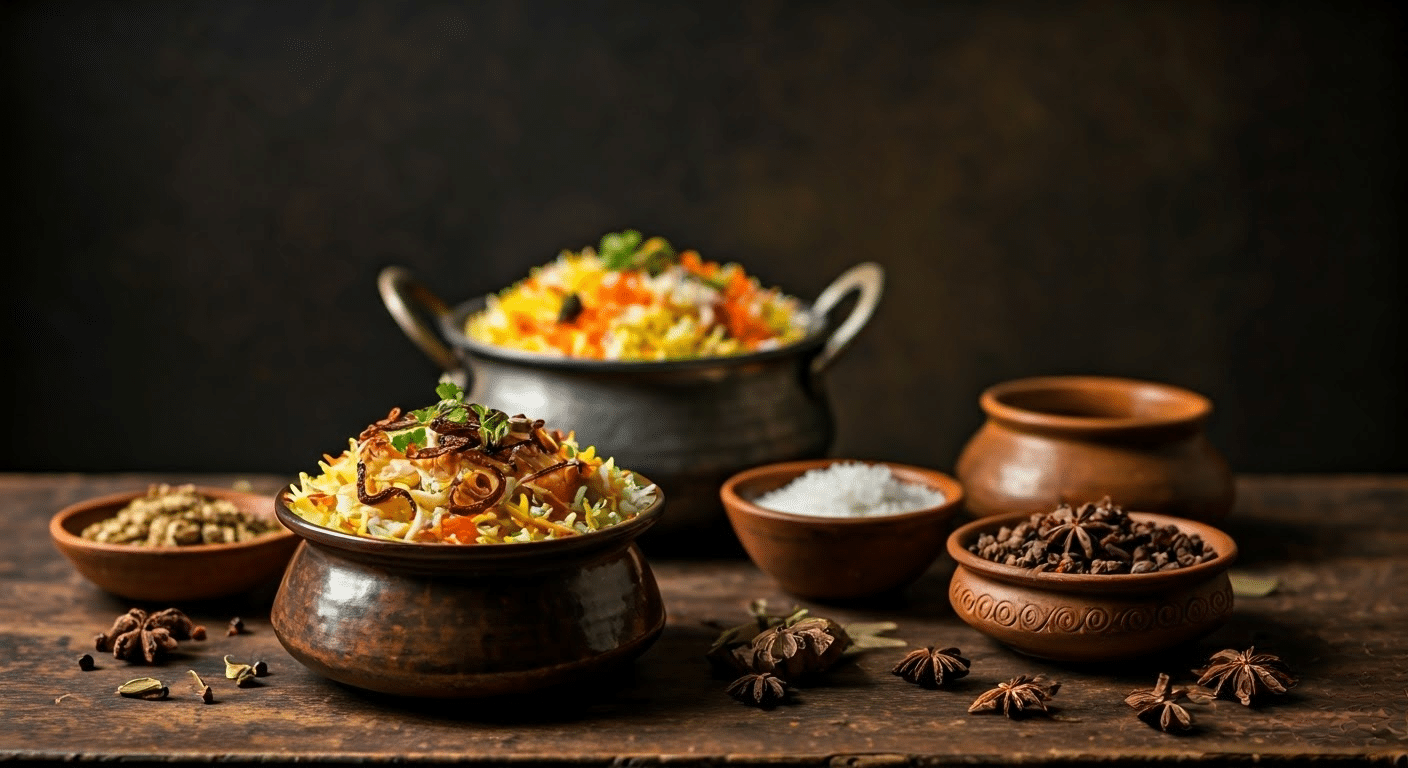
A pot of colorful biryani
The history of biryani seeps into centuries-old culinary traditions and is packed with spicy anecdotes. Whether it’s a mouth-watering mutton biryani, chicken biryani, or a tasty veg version, biryanis carry the imprint of a shared heritage.
Many theories make rounds about biryani history coming from different parts of India, but two major narratives are widely acknowledged. On the one hand, it’s believed that biryani takes its roots from the Persian dish ‘pilaf’, introduced to the Indian subcontinent by the Mughals.
The term “biryani” itself draws from the Persian word ‘birinj’, which means rice. Evidently, the Mughal empire’s influence was not just term-deep. The process of layering cooked rice with a protein source like chicken, imbuing it with various spices, and serving it with raita–all in the dum technique was fundamental to the Mughals.
On the other hand, Arab traders are said to have brought biryani down South. They would prepare this rice meal on their voyages–with meat, spices, and rice slowly cooked together over open fires or on heated charcoal, sealing in exotic aromas. The delicious dish these seafarers perfected continues to tantalise taste buds across India.
The Mughal Influence
The Mughal reign brought much more than warfare and architectural marvels to our Indian subcontinent. The Mughals made significant contributions to the culinary scene, the top among them being the famous biryani. The Mughals prided themselves on their culinary skills in the royal kitchens, where biryani soon became a special dish.
Historians often recount Queen Noor Jahan’s part in introducing biryani to the royal court. She supposedly carried along a biryani recipe when she married Emperor Jahangir, and it wasn’t long before this aromatic dish became a hit in the Mughal courtyard. Such was its popularity that it travelled far and wide, becoming an integral part of Indian cuisine. In addition to biryani making its way into the royal kitchens, it was also preferred by military warriors and was prepared in army barracks as well.
Arab Traders in South India
Arab traders had been immersing themselves in South Indian culture since as early as the 7th Century AD. Along with bartering goods and influences, they brought with them the biryani, adding a new style to biryani history. The rice-and-meat meal was easy to prepare, nutritious and long-lasting, which quickly became an ideal choice for seafarers on their long voyages.
As the Arab traders traversed the spice-laden lands of South India, their biryani continued to evolve, absorbing local flavours and ways. The end result was what we now know and savour as South Indian Biryani. Each South Indian state has its own favoured varieties of biryani, blending in regional tastes to give us a wide assortment of South Indian Biryanis.
Biryani Varieties Across India
Like dialects and clothing styles changing every few hundred kilometres in India, biryani takes new forms across its geographical expanse. You will find a different version of biryani in almost every part of India. So the biryani you will eat in Delhi will be different from the one you eat in Gujarat, Tamil Nadu, etc.
The second half of our journey will take you through the aromatic bylanes of India, savouring the best versions of biryani. Let’s embark on the journey with some Hyderabadi flavour.
1. Hyderabadi Biryani
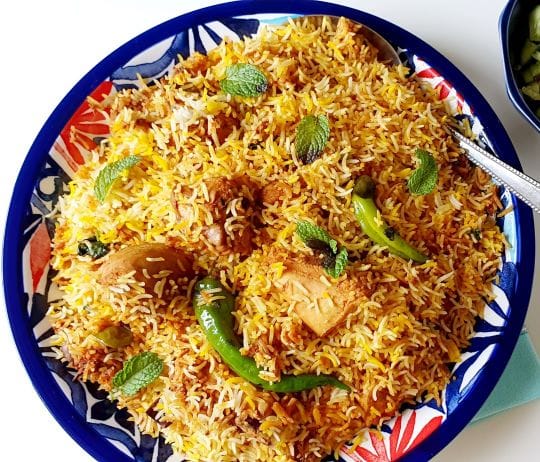
A plate full of Hyderabadi biryani added with green chilies and chicken
Hyderabadi Biryani signifies royalty. This biryani brought together Mughal and Iranian culinary traditions during the rule of Asif Jah, the Nizam of Hyderabad.
- Prepared using long-grain, fragrant Basmati rice and marinated meat, a Hyderabadi biryani owes its quirky taste to an overnight marination process soaked in yoghurt.
- Juicy pieces of marinated meat and partially cooked rice get hermetically sealed and slow cook in their juices.
- These ingredients are then slow-cooked in a pot, creating an extremely aromatic and well-balanced dish that’s a delight to all senses.
- Hyderabadi Biryani gets its unique flavour from a mix of spices and is often served with mirchi ka salan to further satisfy the spice-loving palate.
2. Lucknowi Biryani
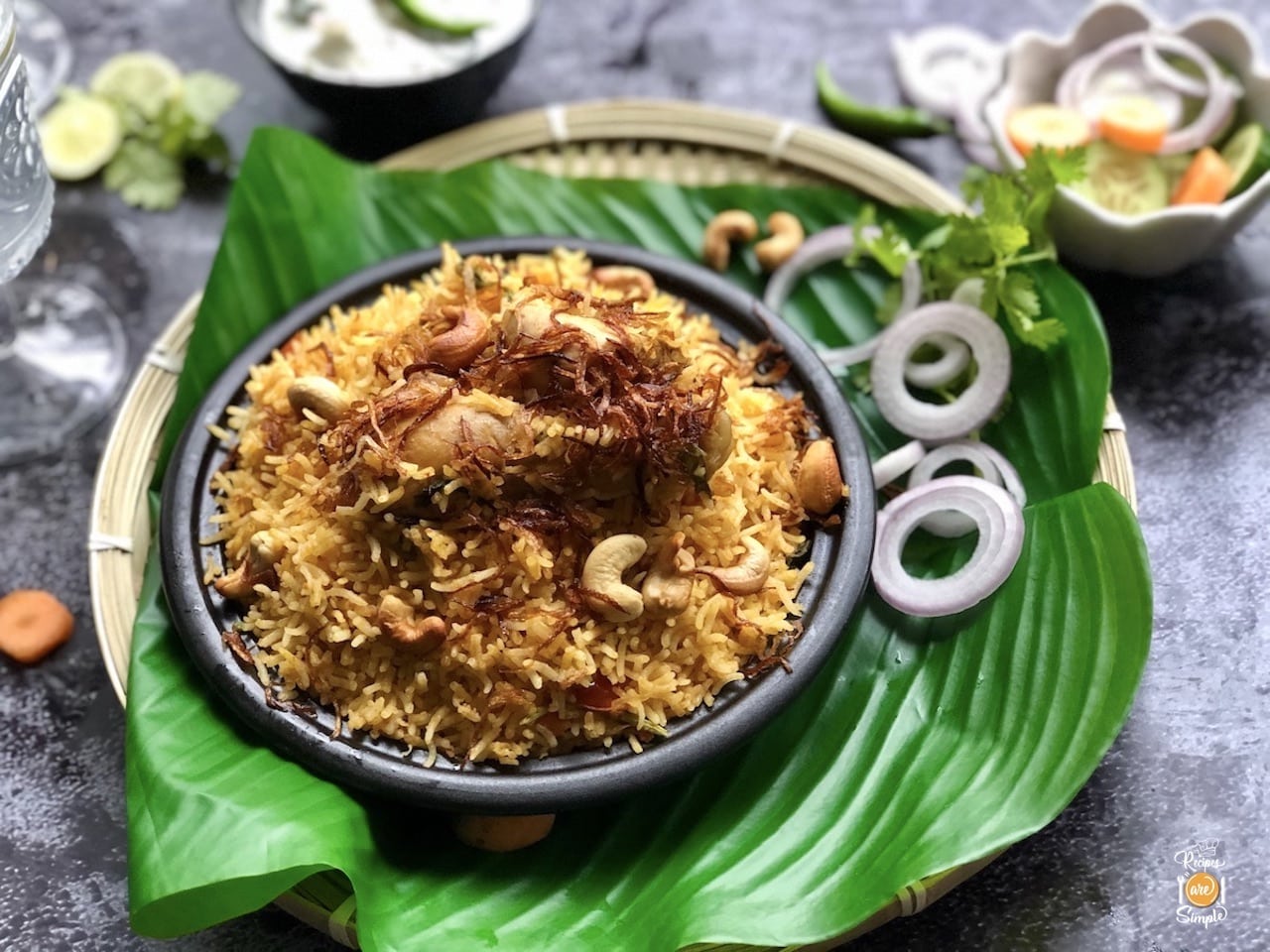
Lucknowi biryani set in a bowl placed on a green leaf
Lucknow, the city of Nawabs, presents a biryani lighter than its over-spiced counterparts but by no means compromises on flavour or aroma. The legendary Lucknowi Biryani springs from the royal kitchens of Awadh.
- Lucknowi biryani is as gentle as the people of the city itself and is celebrated for its delicate flavours and aromatic ingredients.
- Unlike the richly spiced Hyderabadi version, Lucknow-style biryani is more subtle. The rice and the meat are cooked separately before they are layered and cooked together.
- This biryani variety avoids the overuse of spices but employs generous amounts of ghee, giving it a milder, distinct taste.
- The ending of Lucknow biryani includes cooking the layered meat and rice over a slow fire or ‘dum’, allowing the flavours to delicately amalgamate.
3. Kolkata Biryani
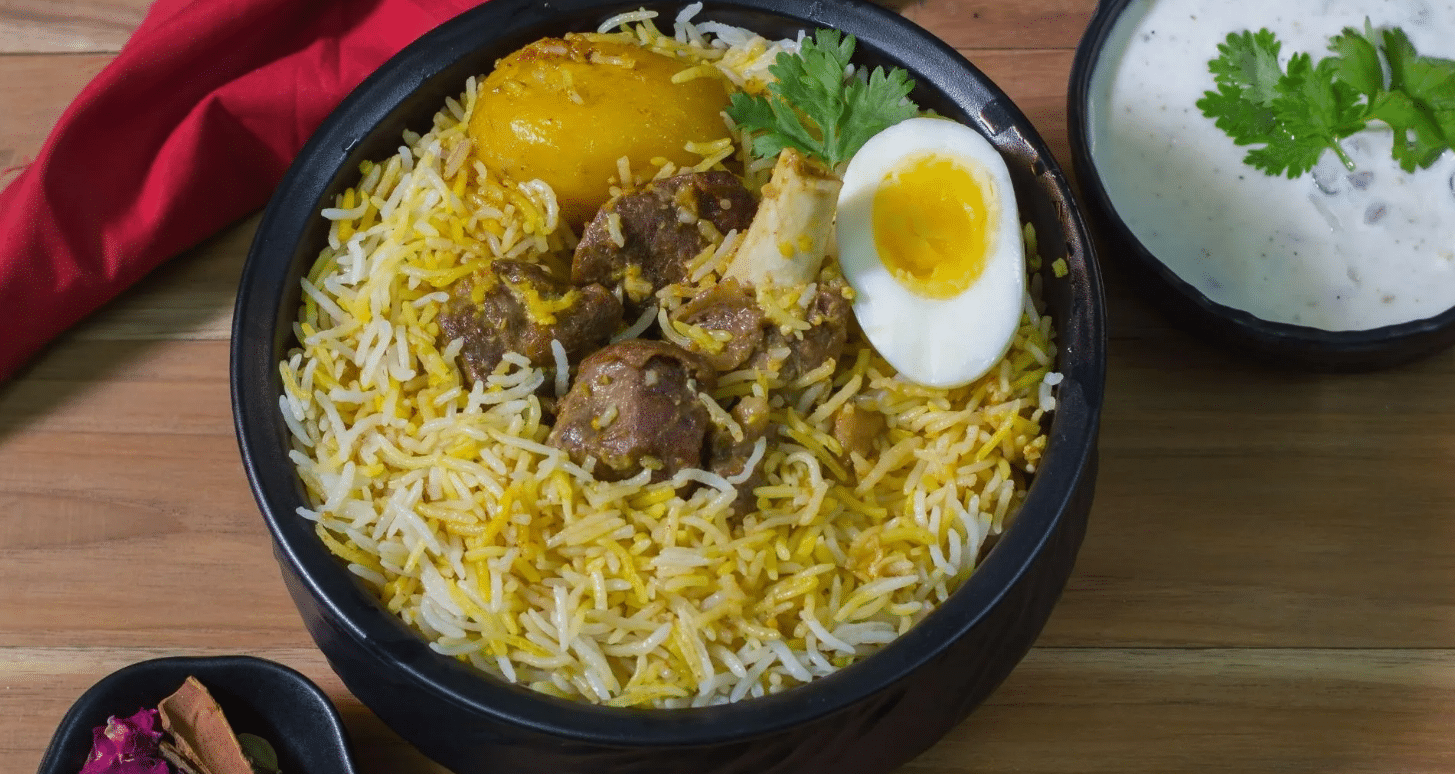
Bowl full of Kolkata’s variety of biryani
Travelling east, we arrive in Bengal, where we are greeted by Kolkata Biryani. Apart from the commonly used spices, Kolkata biryani has an extra ingredient: potato.
- What sets apart Kolkata’s biryani is the use of potatoes and eggs along with meat and fragrant rice.
- Tracing its roots to Nawab Wajid Ali Shah’s reign, Kolkata Biryani has risen through the ranks to become one of the city’s culinary symbols.
- Compared to its counterparts, this biryani tastes sweet due to lesser spice (masala), a characteristic trait of traditional Bengali cuisine.
- Chefs marinate the meat in yoghurt with minimum spices before cooking the rice and meat separately, leading to a more delicate, less spicy, and lighter Biryani.
4. Thalassery Biryani
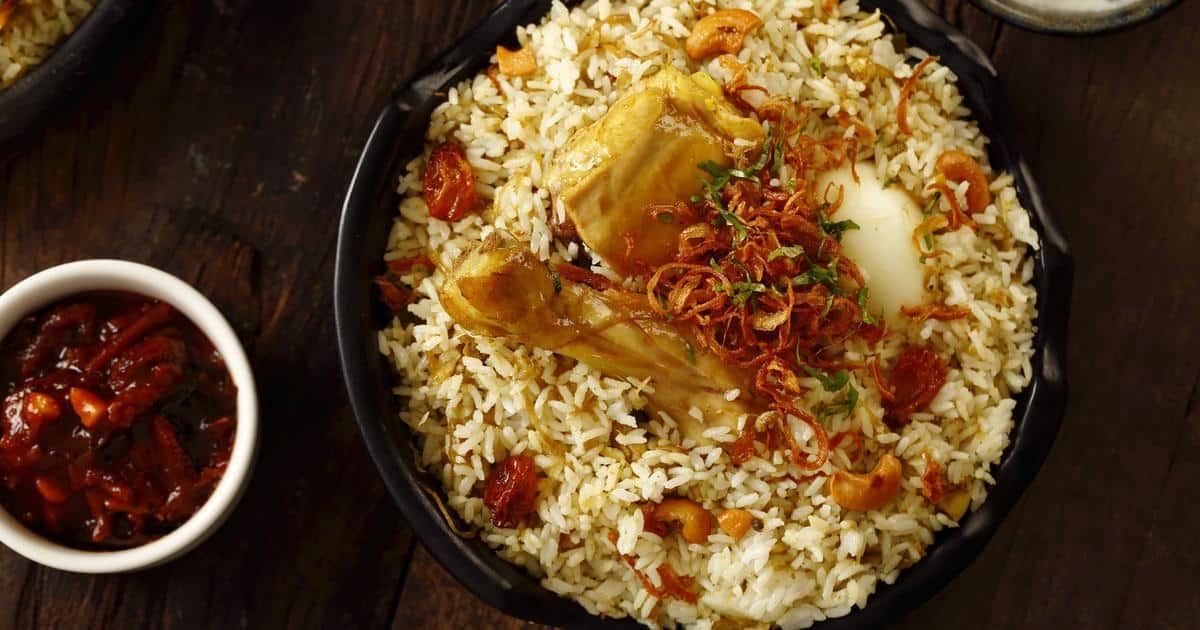
Thalassery biryani is served with red chilli pickle
Thalassery Biryani, from Kerala’s northern corner, marks our final stop. What makes this rendition unique is its use of Jeerakasala, a local rice variant, instead of basmati.
- Basmati rice takes a backseat in Thalaserry Biryani—Jeerakasala, a short-grained, fragrant local variety, becomes the star.
- Unlike others, here, the rice and meat are cooked separately before layering and garnishing with fried onions, cashews, and raisins.
- This coastal delicacy embodies the essence of Kerala with its aromatic blend of Malabar spices and ghee.
- The last touch is a lavish sprinkle of lemon juice, which adds a tangy twist to this already diverse palette of flavours.
Ingredients and Spices in Biryani
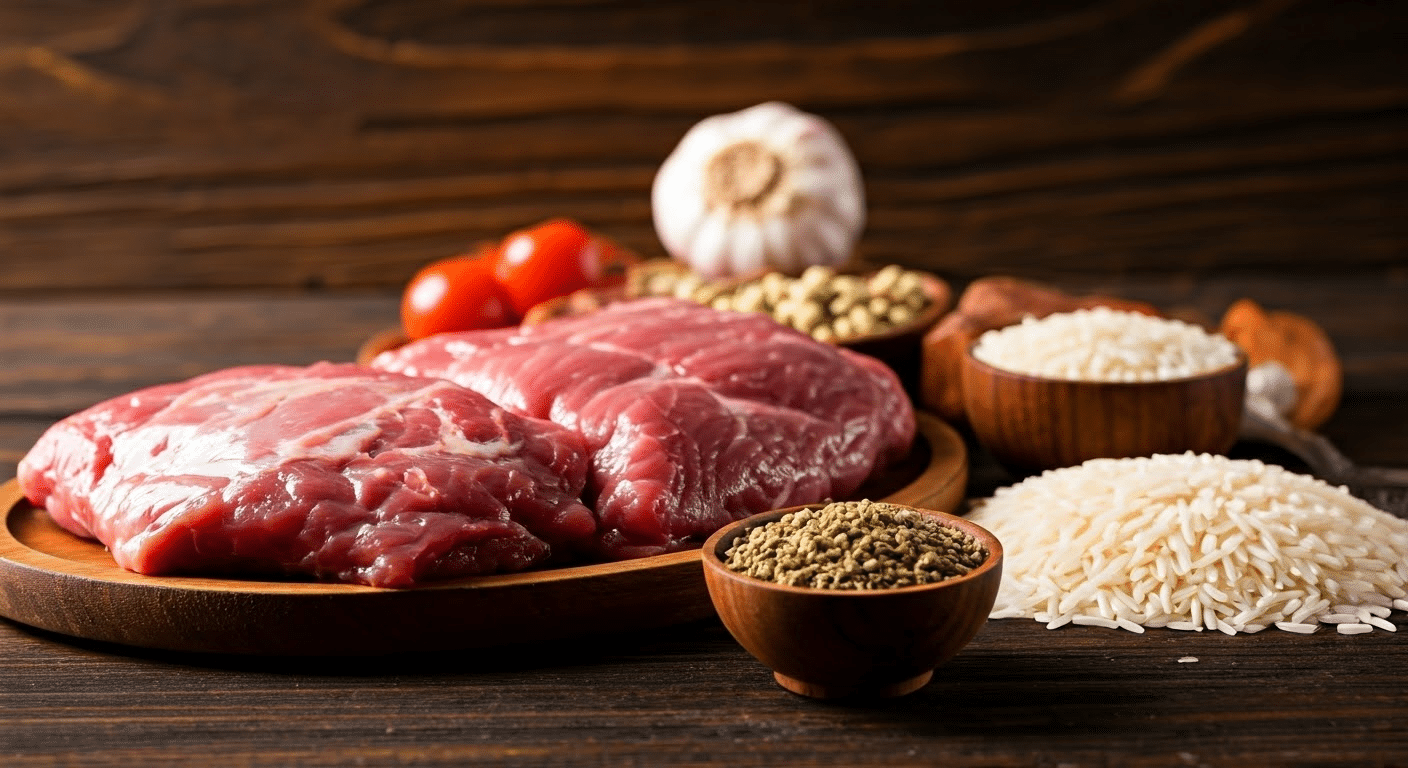
Ingredients for making biryani
Different regions and styles, yet uniting these varied biryani styles, are their base ingredients — meat, rice, and a flavourful medley of spices. Let’s delve into the world of biryani ingredients that interact in harmony to produce the iconic biryani – a dish that transcends the boundaries of states and cultures.
Meat, Rice, and Vegetables
Whether it’s a royal Mughal banquet or an Awadhi kingly feast, biryani truly embraces all — it can be non-veg with varieties such as chicken, mutton or fish, or a veg delight filled with paneer or vegetables.
| Ingredient | Significance |
| Meat | Chicken, mutton, fish, or eggs – type of meat or protein varies as per regional preferences. |
| Rice | Long-grained basmati rice is commonly used, with South Indian biryanis opting for local variants like Seeraga Samba rice. |
| Vegetables | Potatoes, paneer (cottage cheese), and an assortment of vegetables mark the vegetarian versions. |
Exotic Spices and Aromatics
A spectrum of rich and aromatic spices holds the secret to a good Biryani. Though the exact spice blend may differ from region to region, some common elements define the classic biryani flavour.
| Spice | Significance |
| Bay leaf, Cloves, Cinnamon | These trio of spices feature in almost every type of biryani for that authentic taste |
| Cardamom | Green cardamom adds to the fragrant aroma, while black cardamom helps enrich the flavour |
| Saffron, Turmeric | Saffron imparts a delightful yellow hue, and Turmeric blends in a deep, earthy taste |
The Art of Biryani Preparation
The melange of spices, simmering meat, and fragrant rice cooked over a slow fire in sealed pots — the art of making perfect biryani is truly a therapeutic process. As the biryani history shows, timing is key, as is patience, and the result is absolutely worth it. Let us walk you through the painting-like process of the Dum Biryani technique, the layering ritual, and the finishing skills that create a masterpiece called biryani.
Dum Biryani Cooking Technique
Dum biryani is prepared using the ancient cooking method of ‘Dum Pukht’, where ‘dum’ means to ‘breathe in’ and ‘pukht’ translates to ‘cook’. The essence of dum biryani revolves around letting the ingredients simmer in their own juices.
A tightly sealed clay pot traps the steam, enabling all the components inside to coexist and mingle with each other organically. The meat tenderises, the rice absorbs all the meaty flavours, and the spices release their aromatic oils, creating a scrumptious pot of biryani. This slow-cooking technique ensures a delectable play of flavours and textures, making the dish delicious in every bite.
Layering of Biryani
Layering is an integral part of the biryani-making process, often viewed as the art of setting it up for the final leg of preparation. It begins with spreading the partially cooked meat at the base of the cooking pot.
This is then topped off with a layer of partially cooked rice. The process is repeated until all ingredients are duly layered. Each layer gets a sprinkle of fried onions, prawns, boiled eggs or dry fruits as per regional preference.
As these layers slowly cook together, the flavours deeply intertwine with each other, rendering an unparalleled taste to the biryani.
Characteristics of a Good Biryani
An overview of biryani history proves that it can stimulate all your senses, leaving a lingering essence on your palate. Not just flavour, the texture and aroma also contribute to the biryani experience. Here are a few signs of a well-made biryani:
- Flavour: A complex but balanced combination of aromatic spices and clean rice and meat flavours is definitely the star.
- Texture: Neither too dry nor too moist, every grain of rice in biryani should be separate and fully cooked, while the meat has to be tender and juicy.
- Aroma: A good biryani enthrals your nostrils before it delights your taste buds. The fragrance of cooked basmati rice mixed with spices sets an inviting tone.
- Colour: A visually appealing biryani showcases layers of white rice intermingled with orange and yellow hues from saffron and other spices.
Biryani vs. Pilaf: The Differences
Biryani and Pilaf, both rice-based dishes, have common roots in Persia but differ fundamentally in terms of cooking technique, flavours, and presentation. While biryani is layered and often intense with different spices, meat, possibly eggs, and even fruits, pilaf tends to be simpler.
Pilaf dishes usually consist of a uniform mix of cooked rice, spices, and meat, as opposed to biryani’s complex layering. Also, unlike biryani, which requires slow cooking in sealed pots, pilaf is cooked in an open pot. No battle of superiority, just two different dishes, each with its special twist!
Final Thoughts
From the bustling bylanes of Lucknow and Hyderabad to the vibrant shores of Kolkata and Thalassery, biryani has managed to form a delicious, lasting bond with all. The use of diverse aromatic spices, meats, and rice has resulted in a spectacular style of biryani that is part soulful nostalgia and part celebratory feast.
Whether you’re a culinary history buff, a foodie, or just someone who appreciates a delicious, well-cooked meal, the biryani history stirs up as much intrigue as its taste buds. As this journey through the spicy world of biryani comes to a close, we cherish the evolution of this delightful dish that continues to be served with love and enjoyed to the last morsel.
Frequently Asked Questions
Is Biryani an Indian dish or a Persian dish?
Biryani history has Persian roots, but after coming to the Indian soil it transformed and became even more versatile. So, while its etymology is Persian (Birinj meaning rice), its many flavoursome versions are truly Indian.
Why is Biryani so popular in India?
Biryani history holds a special place in Indian cuisine due to its rich flavours, adaptable nature, and the sheer variety it offers. It also serves as a comfort food that unifies diverse palates across different regions of India.
What are some regional adaptations of Biryani?
Our country is home to several regional biryani adaptations. Tracing biryani history from Lucknow’s mild and fragrant biryani, Hyderabad’s spicy variants to Kolkata’s sweet and spiced to Thalassery’s piquant version, each type of this rice dish is famous for its special touch.








